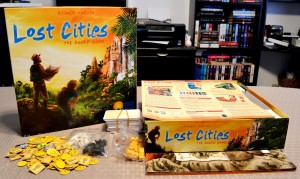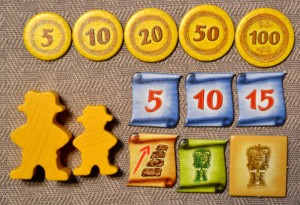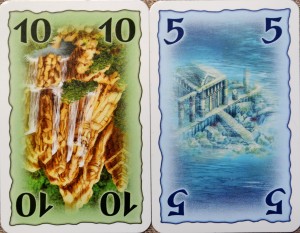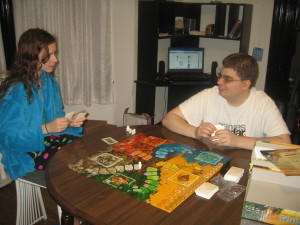It’s been a while since I’ve seen an Indiana Jones-esque game. The last time I played anything remotely close to “Lost Cities” was the board game “Fireball Island” back in the late 80′s. You know, the one with the giant head that shot fireballs from its mouth down various paths on the game board? Its high production values…like the mountains, the artistic detail, etc…stays fresh in my mind to this day. Then there was “Legends of the Hidden Temple” on Nickelodeon back in the mid 90′s, talking totem and all. “Lost Cities” has a similar theme in the form of cards, expeditions, artifacts, bonus points, and adventurer / researcher playing pieces. Before we begin with the review, I want to quickly note that this is NOT the two-player card game version. You can learn more about the card game version by checking out my separate review, here.
Editor’s Note: I published a review for this game years ago, but felt it could be better. As such, this article will serve to modernize my older (AKA crappier) review and bring it up to date with my current review format. A lot of the text has remained as-is, but some of the pictures have been updated. The old review has been retired.
Components
Game Board – The board consists of five separate colored paths branching off from the middle. The top of the board lists two separate score tracks, one of which is used for a one round game while the other is used for the three round game. Each path is made up of “steps”, valued from “-20” through “50”, which is observed during endgame scoring.
Tiles & Tokens – The game includes victory point tokens, event tiles, and artifact tokens. Victory point tokens are awarded at a round’s end so that players can easily compare their scores. Event tiles award players with various bonuses as they explore them on the board. Artifact tokens are awarded to players at the end of a round for every artifact event tile they find, just so they can keep track of how many artifacts they’ve found over the course of three rounds.
Cards – The game includes one hundred and ten cards, consisting of five “suits”: red, yellow, white, blue, and green. Each suit has twenty-two cards per set and have values ranging from “0” to “10”. There are two of each value in a set (two red “1’s”, two red “2’s”, etc.).
Setup & Gameplay
Lost Cities can be played two ways, the long way or the short way. The long way consists of playing three expeditions (rounds) and your points accumulate over all three. The artifacts you collect over all three rounds are tallied at the end and compared to the long game scoring track on the board. The short game consists of one expedition (round) and the artifacts you accumulate for that expedition are compared to the short game scoring track on the board.
The board has five colored paths, each one containing nine steps from the middle of the board to the end of the path. Along each path are event tiles that you can pick up once you land on a particular step. Each step has a point value, starting from a negative number and gradually builds up to a very high positive number on the last step. Players are given four adventurers and one researcher. They don’t have to use all of them.
Event tiles consist of the following:
1) Artifacts (which a player keeps for that expedition, the first person to land on it keeps it for scoring)
2) Points (which stays on the board so others can land on it, players are given point chips so that they can keep track of what they’ve earned)
3) Extra Move (which allows a player to move any one of their meeples an extra space)
The deck of cards is shuffled and depending on how many players are playing, some cards are randomly removed from the deck (and game). The event tiles are randomly put along the paths, face up. Players are dealt eight cards and the game begins.
On a player’s turn, a player can lay down a card from their hand and start a new colored path (if they currently don’t have that color in front of them) or add to an existing one. For every card played of that color, you advance your adventurer or researcher (your choice) along that path.
The kicker is that cards must be played in ascending order, meaning that players need to start their cards low and gradually build up. If they don’t, they won’t advance very far and possibly be stuck on one of the negative steps. Think of the negative steps as the initial cost for starting a new path. It’s a common strategy to only start journeys on the colored paths that reflect what is currently in your hand. If you have a lot of blue cards and only one green card for example, you should probably play blue for a while and leave green in your hand or discard it later.
Instead of playing a card in your hand on your turn, you have the option of discarding. You can discard one card per turn into one of the five face up discard piles, one for each color. When players are done playing a card or discarding a card, they then pickup a card, either from one of the five discard piles or from the deck.
The game ends when the deck runs out, or when a total of five adventurers / researchers cross the bridges on the playing board. You then add up the numbers your adventurers / researchers are currently standing on, any victory points you may have accumulated from the bonus tokens, and compare the number of artifacts you have with the appropriate scoring track. The researcher gets double points for the step he’s on, either positive or negative. Players playing the short game stop here. Players playing the long game are given point tokens to remind them how much they earned that expedition (round) and the game resets…though in the long game, players will not score their artifacts until after the final expedition.
That, in a nutshell, is Lost Cities. The above may seem a little vague or complex in some areas, but keep in mind that this is a review and not a breakdown of the rules. The manual does a better job at explaining the details…this review is just to give you an idea of what you’re in for.
The Review
I personally really like this game. There is a bit of luck in drawing low cards before your opponent does, but the five discard piles help balance that out. There is a lot of strategy involved…as you may have guessed, I like strategy.
For example, let’s say my opponent has a guy on their blue path but is only one or two steps in. I have a guy on the same blue path but further up, though I have very low blue cards in my hand that are useless to me. I have a blue 7 showing, for example, and I have a blue 3 and a 4 in my hand. If I discard them, there’s a very good chance my opponent will scoop those out of the discard pile and use them to advance their own guy. Ergo, one needs to watch what they are discarding.
As another example, I have a few high green cards in my hand and one low green card. Do I start the green path and hope I pickup lower to middle valued green cards along the way so that I can then play my high cards? If I don’t end up getting any, I could be stuck on the negative steps or be forced to play my high cards with a large gap in value in between, reducing my ability to progress along that path.
Even yet another example…A losing player could continuously draw from the discard piles, which slows down the rate at which the deck will run out of cards. A winning player on the other hand, might almost always draw from the deck to try to get it to run out. Remember, when the deck runs out, the expedition is over.
Want my personal recommendation? If you like board games…at all…then pick this one up. The components are top-notch and eye-catching, while the gameplay is both engaging and easy to learn. I enjoy playing the short game, which keeps our play sessions under a half-hour…though the three round session has merit too if you have the extra time on your hands.
Final Verdict: 10/10
—
You can learn more about and purchase “Lost Cities” by visiting the following websites:
http://boardgamegeek.com/boardgame/50/lost-cities
—




